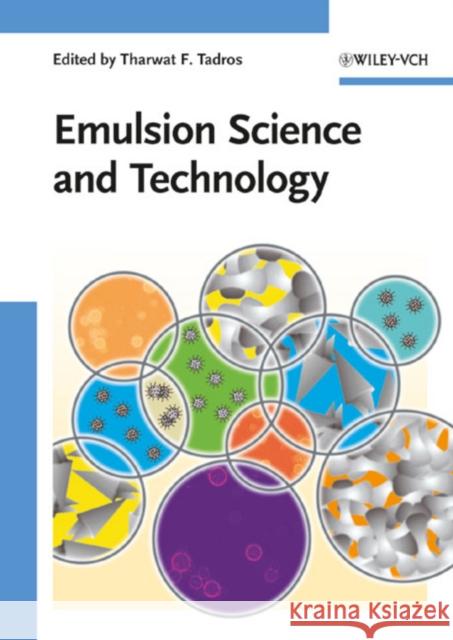Emulsion Science and Technology » książka



Emulsion Science and Technology
ISBN-13: 9783527325252 / Angielski / Twarda / 2009 / 344 str.
Emulsion Science and Technology
ISBN-13: 9783527325252 / Angielski / Twarda / 2009 / 344 str.
(netto: 835,28 VAT: 5%)
Najniższa cena z 30 dni: 875,00 zł
ok. 10-14 dni roboczych.
Darmowa dostawa!
Highlighting recent developments as well as future challenges, this book covers a wealth of topics from Stabilization of Emulsions to Nanocomposites to Sensory Properties of Cosmetic Emulsions.
About the editor:
"Dr. Tadros is a very well recognized individual in the surface chemistry community and is known to write well."
(Prof. Krister Holmberg, Chalmers University, Göteborg, Sweden)
"The author is a well–known scientist in this field with a long experience in colloid science."
(Henkel KGaA, Düsseldorf, Germany)
"Dr. Tadros is well–known in the field of colloid science. High quality can be expected."
(University of Bayreuth, Germany)
"Professor Tadros is a well–known expert on the topic. Because of his industrial experience it might be possible to close the gap between fundamentals and the relevance and applications in the practice."
(Dr. Oetter, BASF AG, Ludwigshafen, Germany)
"Dr. Tadros is a well–known scientist in emulsion and rheology science who can write about fundamentals and applications of surfactants."
(Yokohama National University, Japan)
EMULSION SCIENCE AND TECHNOLOGY: A GENERAL INTRODUCTION
Introduction
Industrial Applications of Emulsions
The Physical Chemistry of Emulsion Systems
The Thermodynamics of Emulsion Formation and Breakdown
Interaction Energies (Forces) Between Emulsion Droplets and Their Combinations
Adsorption of Surfactants at the Liquid/Liquid Interface
Selection of Emulsifiers
Creaming or Sedimentation of Emulsions
Flocculation of Emulsions
Ostwald Ripening
Emulsion Coalescence
Rheology of Emulsions
STABILIZATION OF EMULSIONS, NANOEMULSIONS AND MULTIPLE EMULSIONS USING HYDROPHOBICALLY MODIFIED INULIN (POLYFRUCTOSE)
Introduction
Experimental
Results and Discussion
INTERACTION FORCES IN EMULSION FILMS STABILIZED WITH HYDROPHOBICALLY MODIFIED INULIN (POLYFRUCTOSE) AND CORRELATION WITH EMULSION
Introduction
Materials and Methods
Results and Discussion
ENHANCEMENT OF STABILIZATION AND PERFORMANCE OF PERSONAL CARE FORMULATIONS USING POLYMERIC SURFACTANTS
Introduction
Experimental
Results and Discussion
EFFECT OF AN EXTERNAL FORCE FIELD ON SELF–ORDERING OF THREE–PHASE CELLULAR FLUIDS IN TWO DIMENSIONS
Introduction
The Model
Results and Discussion
THE PHYSICAL CHEMISTRY AND SENSORY PROPERTIES OF COSMETIC EMULSIONS: APPLICATIONS TO FACE MAKE–UP FOUNDATIONS
Introduction
Materials and Methods
Experimental Results and Discussion
NANOPARTICLE PREPARATION BY MINIEMULSION POLYMERIZATION
Introduction
Experimental
Results and Discussion
RECENT DEVELOPMENTS IN PRODUCING MONODISPERSE EMULSIONS USING STRAIGHT–THROUGH MICROCHANNEL ARRAY DEVICES
Introduction
Principles of Microchannel Emulsification
Straight–Through MC Array Device and Emulsification Set–Up
Effect of Channel Shapes on Emulsification Using Symmetric Straight–Through MC Arrays
Effect of Process Factors on Emulsification Using Symmetric Straight–Through MC Arrays
Scaling–Up of Straight–Through MC Array Devices
Emulsification Using an Asymmetric Straight–Through MC Array
ISOTROPIC AND ANISOTROPIC METAL NANOPARTICLES PREPARED BY INVERSE MICROEMULSIONS
Introduction
General Aspects of Microemulsions
Isotropic Nanoparticles
Anisotropic Nanoparticles
PREPARATION OF NANOEMULSIONS BY SPONTANEOUS EMULSIFICATION AND STABILIZATION WITH POLY(CAPROLACTONE)–b–POLY(ETHYLENE OXIDE) BLOCK COPOLYMERS
Introduction
Materials and Methods
Results and Discussion
ROUTES TOWARDS THE SYNTHESIS OF WATERBORNE ACRYLIC/CLAY NANOCOMPOSITES
Introduction
Experimental
Results and Discussion
PREPARATION CHARACTERISTICS OF GIANT VESICLES WITH CONTROLLED SIZE AND HIGH ENTRAPMENT EFFICIENCY USING MONODISPERSE WATER–IN–OIL EMULSIONS
Introduction
Materials and Methods
Results and Discussion
ON THE PREPARATION OF POLYMER LATEXES (CO)STABILIZED BY CLAYS
Introduction
Cloisite Clays and Organoclays
Radical Polymerization
Collective Properties of Polymer/MMT Nanocomposites
Polymer–Inorganic Nanocomposites
General
Tharwat F. Tadros was appointed lecturer in Physical chemistry (1962–1966) at Alexandria University. Between 1966 and 1969, he spent a sabbatical at the Agricultural University of Wageningen and T.N.O. in Delft, The Netherlands. Thereafter he joined I.C.I. and ZENECA until 1994, where he researched various fields of surfactants, emulsions, suspensions, microemulsions, wetting spreading and adhesion, and rheology. During that period he was also appointed visiting professor at Imperial College London, Bristol University and Reading University. In 1992, he was elected President of the International Association of Colloid and Interface Science. Since leaving ZENECA, Tharwat has worked as a consultant for various industries and also given several courses in his specialized field. He is the recipient of two medals from the Royal Society of Chemistry in the UK, and has more than 250 scientific papers to his name.
Two immiscible liquids, one dispersed in the other come together to form the fascinating subject area of emulsion science. The properties and applications of the result of these combinations are of great importance in the world of science today.
Bringing together a wealth of topics from stabilization of emulsions to nanocomposites to sensory properties of cosmetic emulsions, this book highlights recent developments as well as future challenges.
Theory, real life examples and explanations provide the all–round knowledge from industry, research and development. Chapters are authored by some of the top scientists within their respective fields, making this the ultimate guide for those involved in the field of formulations technology.
1997-2025 DolnySlask.com Agencja Internetowa
KrainaKsiazek.PL - Księgarnia Internetowa









